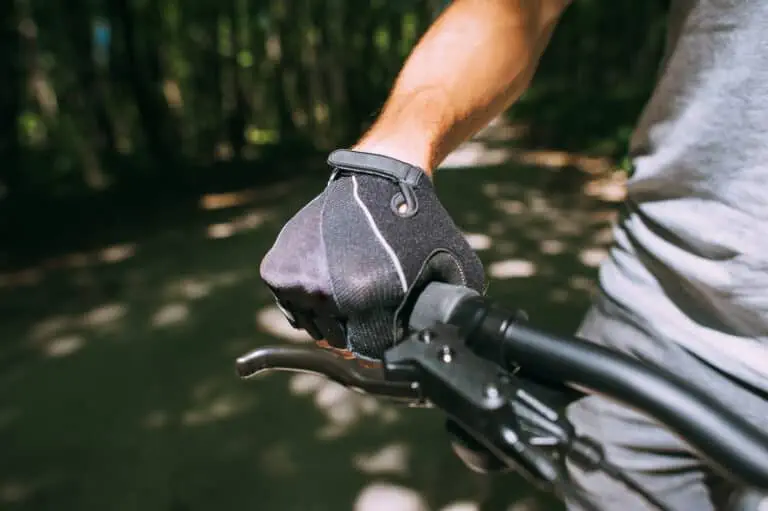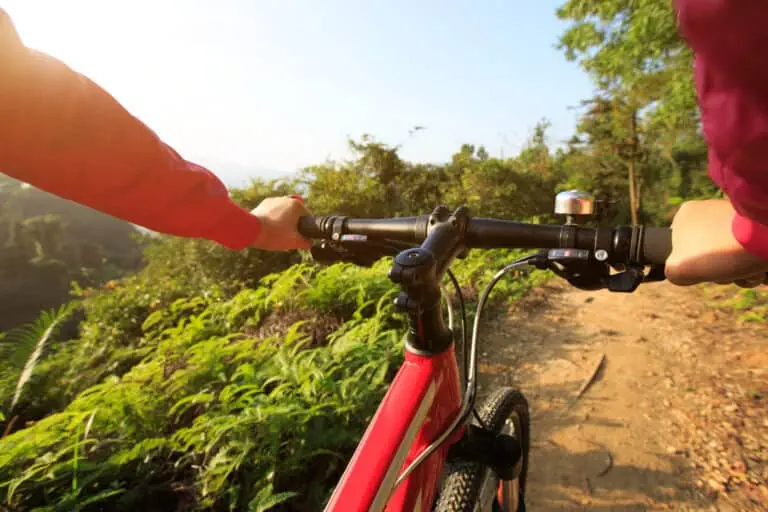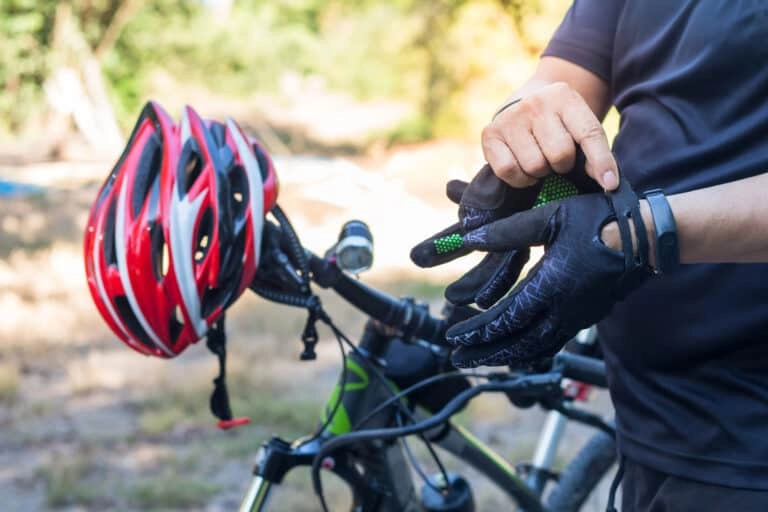When I first started taking longer rides on my bike, I found myself with aching hands and wrists.
My fingers went numb to the point that I couldn’t even work the shifters, and I felt uncomfortable on the brakes.
It took the fun out of riding and even caused me to be slower on the bike.
As it turns out, wrist and hand pain from cycling is one of the most common injuries faced by cyclists.
So if you experience pain when you ride, you’re not alone. But any pain from riding is not normal, and we shouldn’t just accept it as part of the cyclist package.
Instead, there are a number of solutions we can look at to correct the problem.
In this article, we’re going to take a look at the causes and solutions for wrist and hand pain while cycling.
We’ll give you some ideas on how to correct the problems and get back to riding.
Key Takeaways
- Wrist and hand pain shouldn’t be accepted as normal, even though they are common problems
- Sometimes, cycling wrist pain is called handlebar palsy
- Off-the-bike activities, cycling posture, or poor bike fit can cause wrist pain from cycling
- Strength training and a good bike fit can help reduce pain and pressure on the wrists
- You may need to see your doctor if your pain doesn’t improve or is severe

Wrist Pain From Cycling (Why Does It Happen?)
As a new cyclist, I had a lot of anxiety about falling, riding, and especially stopping. All that fear led me to keep a death grip on my hoods and handlebars. Unfortunately, all that tension caused pain in my hands, wrists, shoulders, and neck. The longer I rode, the more I ached.
But that’s just one possible cause of wrist and hand pain – there are a few others, as well.
Handlebar Palsy
This common problem for cyclists is sometimes called “handlebar palsy.” It happens when the ulnar nerve – the nerve that runs from the pinky finger to the ring finger – gets compressed. As a result, you may feel pain, tingling, numbness, and weakness. In addition, you may have trouble changing gears and braking.
The ulnar nerve can become compressed if you have too much weight on your hands when you ride. This can happen if your bike seat is tilted down too far or your handlebars are too low. It can also occur if your handlebars are too wide and you have to hold your wrists at an angle to reach the hoods comfortably. Holding the bars tightly to overcome potholes and rough roads for long periods of time can also cause compression of the ulnar nerve.
Three Most Common Cycling Wrist Pain Causes
- Ulnar nerve compression is probably the most common hand and wrist injury from cycling.
- You may also have pressure on the median nerve by your thumb.
- You may have carpal tunnel pain and numbness.
Solving Cycling Wrist Pain (3 Solutions when You’re Riding)
1. Relax
If you feel like you’re getting sore while riding, try to remember to relax. Loosen up your grip on the handlebars, relax your shoulders, and keep your upper body loose. Try changing your hand position so that your hands and wrists don’t feel tense. Bend your elbows and keep your shoulders relaxed.
2. Try lower pressures (and wider tires)
If you can, use wider tires and lower tire pressure (yeah, sure – the tire swap may be tricky during your ride!). This will absorb some of the lumps and bumps in the road, giving you a smoother, more comfortable ride. You won’t need to grip the bars as tightly, and you’ll be able to relax more.
3. Take a break
Get off the bike from time to time to stretch, shake out your hands, and relax your muscles.
How To Decrease Wrist Pain From Cycling (5 Tips)
1. Try Padded Gloves and Handlebars.
Some of your wrist pain from cycling could be your grip on the hoods or the rough road you are riding on. The easiest step to take is to wear thickly padded bike gloves and even double-wrap your handlebars for more cushion.
Adding in the extra cushion will reduce the tension on your hands and give you a more comfortable ride. Additionally, the extra bar tape will make the handlebars thicker, so you won’t need to grip the bars as tightly. You can loosen your grip on the bars, which will ease the pressure on your hands.

2. Check Your Bike Fit
A poor bike fit can cause you to have too much pressure on your hands, which means hand and wrist pain. If you can, put your bike on a bike trainer and ride like you normally would. While pedaling, remove your hands from the handlebars and place them behind your back. If you fall forward when you let go of the bars, this means your position on the bike needs to be adjusted so that you don’t need to rely on the handlebars to hold you up.
Here’s what to look for when examining your bike fit for wrist pain.
Saddle Position
First, check your saddle position. If your saddle is too high or you’re the nose of your saddle is pointing down too far, the bike will tip you forward, putting too much weight onto your hands.
Handlebar Position
Second, check your handlebar position. For a road rider, you do want your handlebars to be slightly lower than your saddle, but if they are too low and your position is too aggressive, it will push your weight forward and onto your hands. You may need to raise your handlebars to get the weight off of your hands.
Handlebar Width
Third, check your handlebar width. Unless you are on a mountain bike or hybrid bike, the width of your handlebars shouldn’t be wider than your shoulders. If they are, you may be wrapping your hands around the bars to get a better grip, which puts pressure on the nerves of the hand.
If you are hyperextending your wrist to hold on to the hoods, you’ll also be putting extra pressure on the nerves of your hand, which can cause you pain.
Bike Size
Fourth, check your bike size. If your bike is too large, there will be too much space between your saddle and your handlebars (known as the reach). You may need a smaller bike. You can also try putting a shorter stem on the bike and moving your saddle forward to shorten the reach. However, a stem that is too short will make the bike twitchy, and moving the saddle too far forward will make it hard to steer the bike and may cause knee problems.
Find a Bike Fitter
If you have trouble finding the right bike fit that is comfortable, you may need to see a professional bike fitter. They can help solve your pain problems or help you find the right-sized bike.

3. Fix Your Posture On and Off the Bike with Strength Training
Poor posture – on and off the bike – can be a part of your wrist pain. For example, if you work at a computer all day, the strain on your hands from poor positioning could cause your pain on the bike.
When riding, your wrists need to be in a neutral position, not flexed or over-extended. In addition, you should have a slight bend in your elbows, and your shoulders should be down and relaxed.
If you examine your position on the bike and find that your arms are straight and your shoulders are tense and pulled up towards your ears, this could be putting pressure on the nerves in your neck, elbows, and wrists, causing you pain. If this is you, you’ll need to keep working on relaxing your upper body while you ride. This can be a hard habit to break.
Lastly, muscle imbalances can cause you to put too much pressure on your hands as you try to compensate for a lack of core strength with a strained position on the bike.
One of the best ways to work on postural problems is with strength training and stretching. The right exercises will strengthen your core and improve your overall posture, which will relieve some of that pain and tension as you ride, and it will help prevent further injury.
4. Change Up Your Hand Position
Do you find yourself riding in the same hand position all of the time? When I was a newbie cyclist, I clung to the hoods for dear life so that I could have a death grip on the brakes if I needed it. But this was a serious mistake.
Keeping your hands in the same hand position can cause cramping, soreness, and pain in the wrists and hands. Instead, vary your position when you ride and when it is safe to do so.
- When descending, ride with your hands in the drops.
- When climbing, ride with your hands on the top of the bars.
- When riding on flats, you can place your hands gently on the hoods.
Change your hand position frequently to relieve some of the tension and stress on your wrists.

5. See Your Doctor
You shouldn’t have to ride with pain. However, if you’ve tried some of these ideas and still experience pain, or you feel like these ideas aren’t going to help you, go see your doctor. They can provide you with the treatment and support you need so you can hopefully ride pain-free.
Wrist Pain From Cycling Accident
Hand and wrist fractures are common injuries from bike accidents and falls. For example, if a cyclist reaches their hand out to break his fall, that can strain or fracture their wrist, leading to obvious pain! Look out for these five signs of injury:
- Pain
- Warmth
- Swelling
- Redness
- Loss of function
If you have those symptoms in your wrist, you may have sprained or fractured it. You’ll need to seek medical attention. Even a mild sprain can take anywhere from 2 to 10 weeks to heal, so if you have prolonged pain after an accident, make sure to get it looked at by a medical professional.
Final Thoughts on Wrist Pain from Cycling
Wrist and hand pain can be a big nuisance when cycling, making your ride much less enjoyable, but it can also be dangerous. If your hand is numb or becomes weak, you might not be able to shift or brake properly, causing a hazardous situation.
Having pain isn’t normal, even though it is common. Take the steps to correct your bike fit and your posture. Add in strength training, and maybe padded gloves and bar tape. And if you still struggle with wrist pain, make sure you see your local bike fitter and your healthcare professional so you can ride pain-free.
FAQ Suggestions
How do I strengthen my wrists for cycling?
You may need to do some wrist stretches to help open the wrist and alleviate the pain. You probably should see your doctor or physical therapist for exercises related to your specific condition. On the other hand, you can try some of these stretches from Bob and Brad to help you with your wrist pain.
Do cyclists get carpal tunnel?
Yes, cyclists can get carpal tunnel syndrome from riding. It can also happen from working at a computer or doing some other repetitive motion. Carpal tunnel syndrome can occur when the nerves in the wrist get compressed, leading to pain, numbness, and tingling in the hands alongside of weakness. Similar symptoms can be related to problems in the neck and upper back, which compress the nerves.
Is there a garment to ease wrist pain from cycling?
One way to ease wrist pain and prevent injury is to wear padded gloves when cycling. Mountain bike gloves may be more padded than typical road cycling gloves, so find the level of thickness that keeps you comfortable. In addition, the padding may help reduce pressure on the nerves of your hand.

